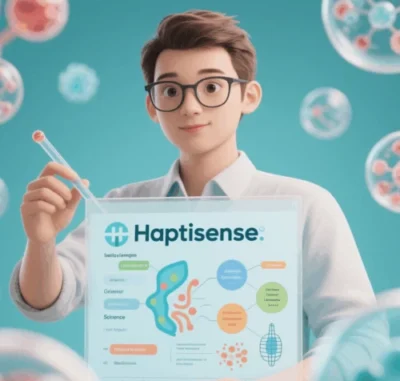
Etymology and Core Definition
Haptisense (or haptic sense) originates from the Greek haptikos (“touchable”) and Latin sensus (“perception”), translating to a tactile perception system. It is defined as:
A biological system that integrates mechanical stimuli (e.g., pressure, vibration), temperature, and pain signals through the synergy of skin, muscles, joints, and the vestibular system, enabling multidimensional perception of object texture, shape, motion, and spatial relationships.
Critically, haptisense is not a single sensory modality but a multimodal perception network, comprising:
- Cutaneous Sensation: Detects surface-level information like pressure, texture, and temperature.
- Proprioception: Monitors body posture and movement via muscles and joints.
- Vestibular Sensation: Perceives gravity and acceleration through the inner ear.
- Deep Pressure Sensation: Responds to sustained pressure in visceral and deep tissues.
Neurobiological Mechanisms
Peripheral Signal Acquisition
- Mechanoreceptors:
- Merkel Cells: Detect static pressure and fine textures (e.g., Braille).
- Pacinian Corpuscles: Respond to high-frequency vibrations (>200 Hz), such as smartphone alerts.
- Ruffini Endings: Sense skin stretch and object slippage.
- Thermal and Nociceptive Receptors: TRP channels (e.g., TRPV1 for heat) and ASIC channels work synergistically.
Central Integration
- Spinal-Thalamic Pathway: Tactile signals ascend via the spinal cord to the thalamus (VPL nucleus) and project to the primary somatosensory cortex (S1) for spatial localization and object recognition.
- Cerebellar-Vestibular Network: Integrates balance and proprioception to maintain coordination (e.g., standing with closed eyes).
- Multisensory Integration: The parietal cortex (e.g., angular gyrus) fuses touch with vision and hearing to construct spatial cognitive maps.
Functional Properties and Cognitive Significance
Active vs. Passive Exploration
- Active Haptics: Object properties (e.g., hardness, elasticity) are acquired through intentional actions like grasping. Studies show a 30% higher recognition accuracy compared to passive touch.
- Passive Haptics: Involves stimuli like wind brushing the skin, offering limited information but lower energy consumption.
Tactile Memory and Emotional Bonding
- Neuroplasticity: Repeated tactile stimulation strengthens synaptic connections (e.g., expanded somatosensory cortex in the blind).
- Emotional Encoding: Warmth activates the insula (linked to safety), while rough textures trigger amygdala responses (linked to aversion).
Social Interaction
- Nonverbal Communication: Handshake pressure conveys trust; back pats express support.
- Cultural Variations: Frequent touch is friendly in Mediterranean cultures, while Nordic cultures prefer tactile distance.
Cross-Disciplinary Applications
Education and Art
- Tactile Pedagogy: Blind children learn geography via tactile maps; 3D-printed models aid anatomy education.
- Haptic Art: Austrian artist Erwin Wurm’s Touch Sculptures invite audiences to reshape artworks through touch.
Healthcare and Rehabilitation
- Prosthetic Feedback: Bionic hands with piezoelectric sensors (e.g., Össur’s Proprio Foot) mimic grip strength.
- Autism Intervention: Weighted blankets in Deep Pressure Therapy alleviate anxiety.
Human-Computer Interaction (HCI)
- Haptic UI:
- Localized Feedback: Smartphone screens with zoned vibrations (e.g., Apple’s Taptic Engine).
- Force Feedback Gloves: Meta’s haptic gloves simulate virtual object resistance using pneumatic actuators.
- Remote Tactile Transmission: Surgeons feel tissue elasticity via the Da Vinci robotic system.
Industry and Design
- Material Optimization: Luxury car interiors use textured surfaces (e.g., Lexus Takumi craftsmanship).
- Virtual Prototyping: Haptic engines (e.g., CHAI3D) simulate fabric friction, reducing physical prototyping.
Technical Challenges and Future Directions
High-Fidelity Tactile Simulation
- Challenge: Current devices lack resolution (human fingertips discern 0.1mm gaps).
- Breakthroughs:
- Ultrasonic Mid-Air Haptics: Ultrahaptics’ STRATOS uses focused sound waves for touchless feedback.
- Neural Interfaces: Cortical microelectrodes (e.g., Neuralink) directly stimulate the somatosensory cortex.
Multimodal Perception Fusion
- Vision-Tactile Learning: MIT’s See-Through Haptics enhances AI object recognition with tactile data.
- Olfactory-Tactile Modulation: Perfume brands design pressure-sensitive sprayers to control scent intensity.
Ethics and Privacy
- Data Security: Hand motion patterns could become biometric identifiers (e.g., device unlocking).
- Sensory Manipulation: Misuse of haptic feedback to drive consumer behavior (e.g., shopping apps mimicking cash texture).
Philosophical and Cognitive Perspectives
- Embodied Cognition: Touch underpins “thinking through the body,” such as holding a warm cup to enhance trust judgments.
- Phenomenology: Philosopher Merleau-Ponty viewed touch as the primal pathway for “intertwining self and world,” transcending visual detachment.
Conclusion
Haptisense, a cornerstone of human perception, is both a marvel of evolution and a catalyst for technological innovation. From neural mechanisms to cross-disciplinary applications, haptic research is redefining education, healthcare, art, and human-machine interaction. As neuroengineering and materials science advance, tactile perception may transcend biological limits, emerging as a “sixth sense” bridging the physical and digital worlds.
If you are interested in purchasing this domain, please contact us via email: chuanchuan810@gmail.com




